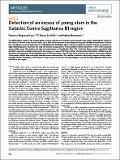Por favor, use este identificador para citar o enlazar a este item:
http://hdl.handle.net/10261/309000COMPARTIR / EXPORTAR:
 SHARE SHARE
 CORE
BASE CORE
BASE
|
|
| Visualizar otros formatos: MARC | Dublin Core | RDF | ORE | MODS | METS | DIDL | DATACITE | |

| Título: | Detection of an excess of young stars in the Galactic Centre Sagittarius B1 region |
Autor: | Nogueras-Lara, F.; Schödel, Rainer; Neumayer, N. | Fecha de publicación: | 25-ago-2022 | Editor: | Springer Nature | Citación: | Nature Astronomy 6: 1178-1184 (2022) | Resumen: | The Milky Way’s centre is the closest galaxy nucleus and the most extreme environment in the Galaxy. Although its volume is less than 1% of that of the Galactic Disk, up to 10% of all new stars in the Galaxy in the past 100 Myr formed there. It therefore constitutes a perfect laboratory to understand star formation under extreme conditions, similar to those in starburst or high-redshift galaxies. However, the only two known young clusters in the Galactic Centre account for <10% of the expected young stellar mass. We analyse the star formation history of Sagittarius (Sgr) B1, a Galactic Centre region associated with strong H ii emission, and find evidence for the presence of several 10 solar masses of young stars that formed ~10 Myr ago. We also detect the presence of intermediate-age (2–7 Gyr old) stars in Sgr B1 that seem to be rare (or absent) in the inner regions of the nuclear stellar disk, and might indicate inside-out formation. Our results constitute a large step towards a better understanding of star formation at the Galactic Centre, such as the fate of young clusters, and the possibly different initial mass function in this region. © 2022, The Author(s). | Descripción: | This article is licensed under a Creative Commons Attribution 4.0 International License, which permits use, sharing, adaptation, distribution and reproduction in any medium or format, as long as you give appropriate credit to the original author(s) and the source, provide a link to the Creative Commons license, and indicate if changes were made. The images or other third party material in this article are included in the article’s Creative Commons license, unless indicated otherwise in a credit line to the material. If material is not included in the article’s Creative Commons license and your intended use is not permitted by statutory regulation or exceeds the permitted use, you will need to obtain permission directly from the copyright holder. To view a copy of this license, visit http://creativecommons.org/licenses/by/4.0/. | Versión del editor: | http://dx.doi.org/10.1038/s41550-022-01755-3 | URI: | http://hdl.handle.net/10261/309000 | DOI: | 10.1038/s41550-022-01755-3 | E-ISSN: | 2397-3366 | Identificadores: | doi: 10.1038/s41550-022-01755-3 issn: 2397-3366 other SEV-2017-0709 |
| Aparece en las colecciones: | (IAA) Artículos |
Ficheros en este ítem:
| Fichero | Descripción | Tamaño | Formato | |
|---|---|---|---|---|
| 2022NatAs...6.1178N.pdf | 2,39 MB | Adobe PDF |  Visualizar/Abrir |
CORE Recommender
SCOPUSTM
Citations
8
checked on 21-abr-2024
WEB OF SCIENCETM
Citations
5
checked on 28-feb-2024
Page view(s)
25
checked on 07-may-2024
Download(s)
18
checked on 07-may-2024
Google ScholarTM
Check
Altmetric
Altmetric
Este item está licenciado bajo una Licencia Creative Commons

